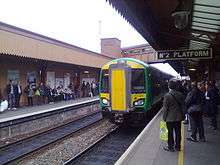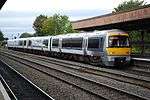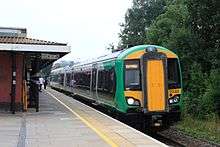Turbostar
| Turbostar | |
|---|---|
|
Class 170 in CrossCountry livery, heading westbound towards Leicester. | |
| In service | 1998 – present |
| Manufacturer |
Bombardier Transportation, Derby (formerly ADtranz) |
| Constructed | 1998 – present |
| Number built | 196 trainsets |
| Formation | 2, 3 or 4 carriages per trainset |
| Capacity | Varies depending on number of cars and seating configuration, see individual articles for details |
| Operator(s) |
Abellio Scotrail |
| Specifications | |
| Car length | 23.62 m (77 ft 6 in) |
| Width | 2.69 m (8 ft 10 in) |
| Height | 3.77 m (12 ft 4 in) |
| Maximum speed | 100 mph (160 km/h) |
| Weight | Varies depending on number of cars and seating configuration, see individual articles for details |
| Prime mover(s) | MTU 6R 183TD |
| Safety system(s) | Various combinations of ATP, AWS, TPWS, Tripcock system |
| Coupling system | BSI[1]/Dellner couplers (Class 171, see below) |
| Track gauge | 1,435 mm (4 ft 8 1⁄2 in) |

Turbostar is the name given to a family of diesel multiple units (DMUs) built by Bombardier Transportation (previously ADtranz) at their Litchurch Lane Works in Derby, England. The Turbostar was the first new train type to be introduced after the privatisation of British Rail. The first units were ordered by Chiltern Railways in 1996 and were designated Class 168 (also known as Clubman). Since then the family has grown with the addition of the Class 170, Class 171, and the Class 172.
Description and technical details
The Clubman/Turbostar/Electrostar platform is a modular design, which share the same basic design, bodyshell and core structure, and is optimised for speedy manufacture and easy maintenance. It consists of an underframe, which is created by seam-welding a number of aluminium alloy extrusions, upon which bodyside panels are mounted followed by a single piece roof, again made from extruded sections. The car ends (cabs) are made from glass-reinforced plastic and steel, and are huck-bolted onto the main car bodies. Underframe components are collected in ‘rafts’, which are bolted into slots on the underframe extrusion. The mostly aluminium alloy body gives light weight to help acceleration and energy efficiency.
Much of the design is derived from the Networker Turbo Class 165 and Class 166 trains built by BREL. Notable features shared are the aluminium alloy frame and two speed Voith T211r hydrodynamic transmission system. The diesel engine has changed to an MTU 6R 183TD. A cardan shaft links the output of the gearbox to ZF final drives (instead of Gmeinder in the Networkers) on the inner bogie of each vehicle. The engine and transmission are situated under the body; one bogie per car is powered, the other bogie unpowered.[2]
Turbostars have been acquired for use by several train operating companies, each with different specifications. One of the more noticeable differences with later units compared to earlier ones are the larger headlights now specified for safety reasons.
Units are numbered 168 xxx, 170 xxx, 171 xxx, or 172 xxx, where xxx is the serial number of the unit. Individual carriages are numbered 50xxx and 79xxx for driving motor cars, and 54xxx, 55xxx and 56xxx for centre cars.
Working in multiple

One factor which contributes to the popularity of the Turbostars is that Class 170 units are fully capable of working in multiple with older types from the Class 15x Sprinter and Class 16x Networker Turbo series of units as well as other units of the same class,[3] unlike all other types built since privatisation, giving them much more flexibility. However, there are issues with so-called "sandwich" formations, formed either 170-15x-170 or 15x-170-15x, which causes problems with empty stock movements where up to 4 units of various types coupled together is common. A possible side effect of this is that Turbostars' performance is in line with the second generation 15x units, in fact being somewhat slower than a Class 150 or Class 156 on "short hop" workings, and slower than a Class 158 on longer distance workings unless there is enough 100 mph running to take advantage of the 10 mph higher top speed of the Class 170.
The Class 171 units are fitted with Dellner couplers rather than BSI (Bergische Stahl Industrie) couplers, which means that they can mechanically couple with Southern's Class 377 Electrostar EMUs for rescue purposes.
Turbostar variants
| Class | Image | Operator | Introduced | Number | Carriages | End gangways |
|---|---|---|---|---|---|---|
| 168 "Clubman" |  | Chiltern Railways | 1998-2004 | 19 | 3 or 4 | No |
 | ||||||
| 170 | .jpg) | CrossCountry Abellio ScotRail London Midland Abellio Greater Anglia | 1998 | 122 | 2 or 3 | No |
| 171 |  | Southern | 2003 | 16 | 2, 3 or 4 | No |
| 172 |  | Chiltern Railways London Midland London Overground | 2010 | 39 | 2 or 3 | 172/2 and 172/3[4] |
 |
References
- ↑ "System Data for Mechanical and Electrical Coupling of Rail Vehicles". Rail Safety and Standards Board. Archived from the original on July 5, 2008. Retrieved 2009-01-05.
- ↑ "TURBOSTAR - United Kingdom". Bombardier.com. Retrieved 2010-05-22.
- ↑ "CLASS 170 'Turbostar'". Therailwaycentre.com. Retrieved 2010-05-22.
- ↑ "Class 172 Technical Data". Therailwaycentre.com. Retrieved 2010-05-22.
Further reading
- West, Lee (7–20 October 1998). "'Turbostar' is ready to roll!". RAIL. No. 341. EMAP Apex Publications. pp. 22–25. ISSN 0953-4563. OCLC 49953699.
